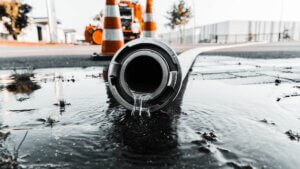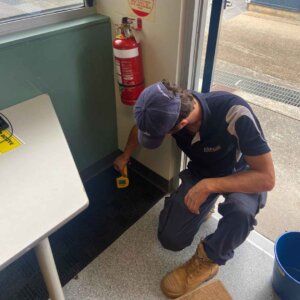Water Damage Restorations: The Latest Technologies and Techniques
Water Damage Restorations: The Latest Technology and Techniques
Summary
Discover the cutting-edge technologies and techniques revolutionizing water damage restorations in this comprehensive article. Professionals now utilize moisture mapping and infrared thermography to pinpoint hidden water sources, while advanced water extraction equipment swiftly removes standing water. Rapid structural drying techniques with dehumidifiers and air movers prevent further damage. Thermal imaging cameras detect hidden water pockets, and low-grain refrigerant dehumidifiers speed up the drying process. Ozone generators effectively remove odours, and controlled demolition preserves original materials. Additionally, document drying, moisture-activated monitoring systems, and advanced anti-microbial treatments ensure efficient and thorough restoration. Trust AllAces Cleaning & Restoration, with over 35 years of experience, for exceptional results.
Welcome to the world of water damage restorations, where innovation and expertise converge to mitigate the devastating effects of water-related incidents. As the demand for efficient restoration solutions grows, so does the need for staying up to date with the latest technologies and techniques. In this comprehensive article, we will delve into the advancements that are shaping the field of water damage restorations. From state-of-the-art equipment to advanced methodologies, we will explore how these technologies are revolutionizing the industry and ensuring a more rapid and successful recovery from water damage incidents.
The Latest Technologies in Water Damage Restorations
- Moisture Mapping and Infrared Thermography
Effective restoration starts with accurate assessment, and moisture mapping combined with infrared thermography has transformed the way professionals identify moisture intrusion. This technology allows experts to pinpoint hidden water sources within walls, ceilings, and floors without causing unnecessary damage. By creating a moisture map, restorers can develop targeted action plans, leading to quicker and more efficient restoration processes.
- Advanced Water Extraction Equipment
Modern water damage restorations companies employ high-powered extraction equipment that can swiftly remove standing water from affected areas. Specialized pumps and vacuums designed to handle various surfaces ensure efficient water removal, minimizing the risk of secondary damage like mould growth and structural weakening.
- Rapid Structural Drying Techniques
Gone are the days of relying solely on natural evaporation for drying structures. Advanced rapid structural drying techniques, such as the use of industrial-grade dehumidifiers and air movers, accelerate the drying process. This prevents further damage, reduces downtime, and aids in preserving the integrity of the affected building materials.
- Thermal Imaging Cameras for Detecting Hidden Water
Thermal imaging cameras have become indispensable tools in water damage restorations projects. By detecting temperature anomalies, these cameras identify hidden water pockets that may not be visible to the naked eye. This technology allows restorers to target specific areas for remediation, leading to more precise and effective restoration efforts.
- Low-Grain Refrigerant (LGR) Dehumidifiers
LGR dehumidifiers are a recent breakthrough in the restoration industry. They are designed to remove moisture efficiently, even in low-humidity environments. These dehumidifiers can significantly speed up the drying process, making them an invaluable asset for water damage restorations projects in Australia, where weather conditions can vary.
- Ozone Generators for Odour Removal
Unpleasant odours are common after water damage incidents. Ozone generators are used to neutralize odour-causing molecules, leaving the affected area smelling fresh and clean. This advanced technology eliminates the need for masking agents and ensures a thorough deodorization process.
The Latest Techniques in Water Damage Restorations
- In-place Drying vs. Pack-out Method
In-place drying involves restoring items within the affected area, while the pack-out method involves removing items to an off-site facility for restoration. The latest approach involves a combination of both techniques, allowing for efficient drying of larger spaces while providing more focused restoration for valuable belongings.
- The Use of Desiccants in Extreme Humidity
In areas with extremely high humidity levels, desiccants have proven to be effective in water damage restorations. These materials absorb moisture from the air, reducing humidity and promoting faster drying.
- Controlled Demolition for Precision Restoration
Instead of wholesale demolition, controlled demolition techniques are employed to remove only the damaged portions of structures. This approach preserves as much of the original building materials as possible, resulting in faster and more cost-effective restoration.
- Document Drying and Restoration
For properties with important documents or valuable artworks affected by water damage, specialized document drying, and restoration techniques are employed. Freeze-drying, vacuum thermal drying, and other innovative methods ensure the preservation of these valuable items.
- Moisture-Activated Monitoring Systems
Moisture-activated monitoring systems provide real-time data on moisture levels during the restoration process. These smart systems help restoration teams make informed decisions and adjust their strategies for maximum efficiency.
- Advanced Anti-Microbial Treatments
To prevent mould growth and ensure a hygienic environment, advanced anti-microbial treatments are applied to affected surfaces. These treatments are more effective and environmentally friendly than traditional chemical solutions.
Frequently Asked Questions (FAQs)
How long does water damage restoration usually take?
Water damage restoration timelines vary depending on the extent of the damage, the size of the affected area, and the techniques used. In general, smaller-scale incidents can be resolved within a few days, while larger and more complex projects may take several weeks.
Can I handle water damage restoration on my own?
While minor water damage incidents can be addressed by homeowners, it’s essential to remember that water damage restoration requires specialized knowledge, equipment, and expertise. For significant incidents, it is highly recommended to hire professional restoration services to ensure thorough and effective restoration.
Will my insurance cover the cost of water damage restoration?
Most standard home insurance policies include coverage for sudden and accidental water damage. However, it is essential to review your policy and consult with your insurance provider to understand the extent of the coverage and any specific requirements for claims.
Is mould growth a concern after water damage restoration?
Mould growth is a common concern after water damage incidents. Professional restoration services include thorough drying and anti-microbial treatments to prevent mould growth and ensure a safe living environment.
How can I prevent water damage in the future?
Regular maintenance, prompt repairs of leaks, and installing water detection devices can help prevent water damage in the future. Additionally, knowing the location of shut-off valves and having an emergency plan can minimize the impact of potential water-related incidents.
Can water damage restorations services help with sewage backups?
Yes, reputable water damage restoration services are equipped to handle sewage backups and other hazardous situations. They have the necessary training and equipment to mitigate these types of incidents safely and effectively.
The latest technologies and techniques in water damage restorations have transformed the industry, enabling professionals to respond swiftly and effectively to water-related disasters. From advanced equipment for rapid extraction and drying to innovative methodologies for precision restoration, these advancements are revolutionizing how we recover from water damage incidents. Whether you’re a homeowner dealing with a minor leak or a commercial property owner facing significant water damage, staying informed about these cutting-edge solutions can make all the difference in restoring your property to its pre-damage condition.
Why Choose AllAces?
At AllAces Cleaning & Restoration, we offer 24/7 service for urgent water damage restorations requests. Our IICRC-certified technicians have more than 35 years of industry experience to ensure unmatched results and the return of your property to a pre-loss condition. Utilising the latest technology and equipment, AllAces continues to offer a range of services and specialties to complete all remediation requirements.



